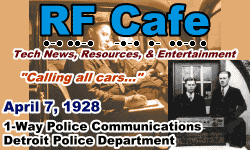|
  April 7 April 7
1827: Englishman John Walker sold his first
friction
matches. 1860: W(ill) K(eith) Kellogg, founder of the Kellogg cereal company,
was born. 1913: The first electrically propelled ship of the U.S. Navy, the
U.S.S. Jupiter, was
commissioned. 1927: Bell Laboratories and the Department of Commerce held the
1st long-distance transmission of a live picture and voice (television) simultaneously. 1928: The
Detroit Police Department commenced regular one-way radio communication
with its patrol cars. 1945: Japan's largest battleship of WWII, the
Yamato, was sunk by Allied forces. 1947: Automobile magnate
Henry Ford died. 1953: IBM unveiled the
IBM 701 Electronic Data Processing Machine - their first commercially
available scientific computer. 1957: The last of New York City's electric trolleys
completed its final run from Queens to Manhattan. 1959: The first atomic generated
electricity was produced at Los Alamos Scientific Laboratory, NM. 1959: The first
radar signal was bounced off the sun from Stanford, CA. 1981:
Willem Klein
mentally extracted the 13th root of a 100-digit number in 29 seconds. 1983: Story
Musgrave and Don Peterson made the first Space Shuttle spacewalk. 2015: U.S. patent
#9,000,000
was awarded for Windshield Washer Conditioner.
| Jan
| Feb | Mar |
Apr | May |
Jun | Jul |
Aug | Sep |
Oct | Nov |
Dec |
Note: These
historical tidbits have been collected from various sources, mostly on the Internet.
As detailed in
this article, there
is a lot of wrong information that is repeated hundreds of times because most websites
do not validate with authoritative sources. On RF Cafe, events with
hyperlinks have been verified. Many years ago,
I began commemorating the birthdays of notable people and events with
special RF Cafe logos.
Where available, I like to use images from postage stamps from the country where
the person or event occurred. Images used in the logos are often from open source
websites like Wikipedia, and are specifically credited with a hyperlink back to
the source where possible.
Fair Use laws permit
small samples of copyrighted content.
|










